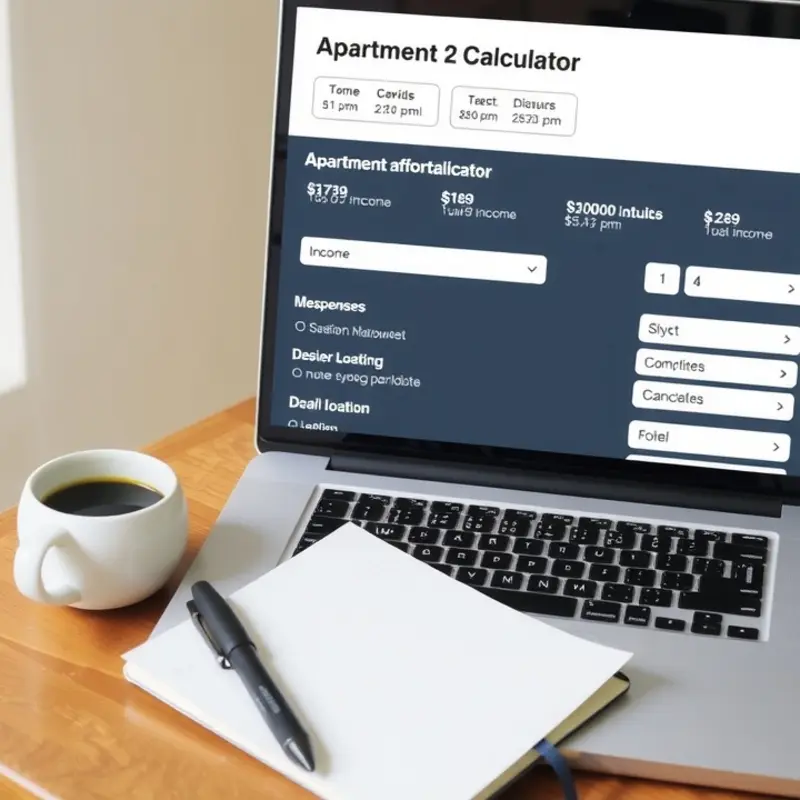Finding the right apartment is a balancing act for young professionals, students, couples, and families. With varying incomes and expenses, understanding what you can afford is crucial. Apartment affordability calculators serve as essential tools that provide financial clarity. These calculators help demystify housing budgets by factoring in crucial elements such as income, expenses, and desired lifestyle. Whether you’re venturing into the rental market for the first time or searching for a new family home, these tools can ease your worries about lease agreements and financial commitments. By outlining your monthly income and expenditures, these calculators empower you to make informed decisions, ensuring that you don’t stretch your budget too thinly. This comprehensive guide will explore the functionality of these calculators and provide expert insights on how to effectively use them for smart renting strategies, no matter where you are in your residential journey.
Understanding the Basics of Apartment Affordability Calculators

Apartment affordability calculators play a crucial role in guiding potential renters through financial planning. Designed to compare income with anticipated living expenses, these tools help in understanding what rent one can comfortably afford. Generally, they factor in monthly income, existing debts, and other financial obligations. The results, though straightforward, provide a pivotal foundation for financial decisions, ensuring they align with one’s overall budget and lifestyle goals.
Key components of these calculators include income input, often requiring users to enter monthly or annual figures. Beyond income, debt analysis is crucial. These calculators account for loans, credit cards, and additional monthly payments, painting a holistic picture of financial health. Operators also enter anticipated utility costs, which significantly impact disposable income. This input results in a comprehensive output that informs potential renters about their financial capacity without overstress.
These calculators are indispensable for various demographics. Young professionals typically see a fluctuation in income as careers evolve. By using an affordability calculator, they manage their budgets effectively, ensuring that chosen apartments match financial reality. Students, often with limited budgets, benefit immensely. Calculators prevent the common pitfall of overextending financially when living near campus or in bustling areas.
Couples and families use these tools to meld incomes and expenses, ensuring that joint financial plans accommodate all household needs. This process becomes particularly important for families balancing additional costs linked to children, such as schooling and childcare. It’s not uncommon to use these tools alongside a financial planning guide to develop a well-rounded budget strategy.
Interpreting results requires an understanding of percentages often highlighted by such calculators. A common rule of thumb suggests that housing expenses should not exceed 30% of monthly income. However, given varying circumstances, this percentage can adapt. Users should visualize the outcome as a guideline, not a strict rule, and consider it alongside personal financial strategies.
The ripple effect of effective use ranges from improved credit ratings to reduced financial strain. Opting for what’s affordable rather than the maximal option creates economic resilience and lowers the risks associated with unforeseen expenses. The boundary between comfort and financial overstretch is often thin, making these tools invaluable.
In essence, affordability calculators offer a critical glance into future expenditures, guiding informed decision-making. They distill complex financial data into digestible insights, paving the way for secure housing choices that bolster long-term well-being.
Maximizing Your Budget: Practical Tips and Strategies

Maximizing your budget during an apartment search can significantly impact the quality of your living situation. Here’s how affordability calculators can be indispensable tools for making informed decisions.
Accurately Input Data
Start by gathering comprehensive financial information. This includes your monthly income, any debt obligations, and other regular expenses. Accuracy is crucial when using affordability calculators—underestimating expenses can lead to living beyond your means.
Use your net income, the amount after taxes, rather than gross income, to get a realistic view of your purchasing power. Be meticulous when entering this information into the calculator. Small errors can lead to misleading results.
Consider Additional Costs
Apart from rent, consider additional costs like utilities, insurance, and maintenance fees. Often, these expenses can dramatically change your affordability perception. Some landlords include utilities in the rent, while others do not. Research typical utility costs in areas you’re considering.
Insurance is another critical element. Renters insurance provides security against unexpected events, and its cost varies based on location and the covered assets. Incorporate this into your budget calculations to avoid surprises.
Recommended Budget Percentages
Finance experts often advise spending no more than 30% of your income on housing. However, this guideline isn’t one-size-fits-all. Adjust this percentage based on your unique financial obligations.
A more precise approach might be the 50/30/20 rule: Allocate 50% of income to necessities, 30% to discretionary spending, and 20% to savings and debt repayment. Tailor these figures to your lifestyle and comfort level. If urban living is your preference, you might choose to spend a bit more on housing and less elsewhere.
For more personalized financial advice, consider reading our guide on financial planning for renters. It offers in-depth strategies to refine your spending habits, which can make apartment hunting more strategic.
Lifestyle Considerations
Your lifestyle choices significantly influence your apartment affordability. Factor in proximity to work, public transportation, and leisure activities. Living further from the city center might lower rent but increase commuting costs and time.
Reevaluate your priorities and determine which aspects of your lifestyle are negotiable. Would a smaller living space suffice if it means living in a vibrant neighborhood? Recognize your needs versus wants.
Utilizing the Calculator
Finally, use the affordability calculator as a guiding tool, not the sole deciding factor. Consider touring potential apartments or neighborhoods to get a better sense of what’s important to you. On-the-ground research can reveal insights that a calculator might overlook.
By integrating these factors into your search, you create a well-rounded perspective on what you can afford and where you want to live. The balance between financial discipline and lifestyle satisfaction is crucial in finding an apartment that feels like home.
Final words
Apartment affordability calculators are invaluable for anyone looking to rent. They not only provide insights into your financial situation but also empower you to make educated decisions that can save you money. By understanding your budget and the factors affecting rental prices, you can confidently navigate the rental market, ensuring you find a home that suits your needs without overstretching your finances. Whether you’re a young professional, a student, or a family, leveraging these tools can significantly enhance your apartment-hunting experience, leading to better financial stability and satisfaction in your living arrangements.









